![]()
![]()
![]()
Use LEFT and RIGHT arrow keys to navigate between flashcards;
Use UP and DOWN arrow keys to flip the card;
H to show hint;
A reads text to speech;
114 Cards in this Set
- Front
- Back
|
What are the three domains in which all living organism are divided into?
|
Bacteria
Eukarya Archaea |
|
|
How does the bond energy of hydrogen bonds compare to covalent bonds?
|
Hydrogen bond energy is weaker than covalent bonds but in large quantities, they are strong.
|
|
|
Describe the characterisitics of a hydrogen bond.
|
Weak bond, electrostatic interactions
Occurs between the atom with a charge and another atom that has opposite charge They have a distinct bond angle and bond length, |
|
|
Why are Van Der Waals interactions also referred to as Dispersion Forces?
|
The distribution of electronic charge changes with time. As atoms get closer and closer, the attraction forces increase. However, once they get within the "van der Waals contact distance" the atoms begin to repel each other as they get closer to each other. The group of molecules are known as nonpolar molecules and E = 1/r^6
|
|
|
What is the significance of hydrogen bonding in biochemical structures such as proteins?
|
Stabilize folding allows for conformation changes.
|
|
|
Is aromatic stacking the same as the hydrophobic effect? explain.
|
Hydrophobic effect is a non-polar molecule in water attempts to move away from it and interacts with as few molecules as possible and with as much of it own as possible.
Aromatic stacking is the hydrophobic effect of flat base pairs and it occurs in one plane |
|
|
The alpha helical segment of proteins stop whenever a proline is encountered in the chain. Suggest a reason why Pro is not present in an alpha helix.
|
Proline causes kinks, alpha helix can't have any kinks. It must have a constant diameter and coil structure.
|
|
|
What is a Ramachandran plot and what does it show?
|
Shows the combinations of phi (N-C) and psi (C-C) bond angles possible.
Shows that not all Phi & Psi bond angles are possible. there are many combinations possible because of steric hindrance. This is why folding leads to beta sheets and alpha helices |
|
|
In an alpha helix, part of the sequence reads: A D E G Y E I I K S A Which amino acids are likely to be found on the side of the helix that faces the interior of the globular protein it is part of and which are facing the aqueous solvent. Explain your answer.
|
Make a wheel.
- charged Polar aa are on outside (D E Y E K S) Uncharged aa are on the inside (remember polar aa Q N DEH KRSTY) |
|
|
What is the one letter abbreviation for: Ala
|
A
|
|
|
What is the one letter abbreviation for: Arg
|
R
|
|
|
What is the one letter abbreviation for: Ser
|
S
|
|
|
What is the one letter abbreviation for: Asp
|
D
|
|
|
What is the one letter abbreviation for: Asn
|
N
|
|
|
What is the difference between a protein motif and a protein domain?
|
Motif - combinations of secondary structures (i.e. alpha turn alpha)
Domain - Assembly of various motifs form independent units of structure. Entire protein has tertiary structure. |
|
|
What are some methods involved in Protein Purification?
|
Ammonium Sulfate Precipitation
Ion-Exchange Chromatography Polyacrylamide Gel Electrophoresis |
|
|
What are some methods involved in amino acid sequence analysis?
|
Hydrolysis w/6 M HCl - Produces randomized fragments
Sanger reagent - Determines N-end Carboxypeptidase - Determines C-end, but does not stop, so short incubations are performed Phenyl isothiocyanate - aka Edman degradation binds to N-end while the remaining peptide stays intact. Trypsin Digestion - Cleaves at C end of K & R Cyanogen Bromide (CNBr) - Cleaves at the C end of M Chymotrypsin - Cleaves at C end of F, Y, or W |
|
|
In protein purification, what is Ammonium Sulfate Precipitation used for?
|
Used after centrifugation to "Salt Out" proteins. Different concentrations will salt out different proteins due to solubility competition with water.
|
|
|
In protein purification, what is Ion-Exchange Chromatography used for?
|
Separate proteins based on charge. Put proteins in column filled with negatively charged beads. The positive proteins will be attracted and the negative proteins will flow out of the column first.
|
|
|
In protein purification, what is polyacrylamide Gel Electrophoresis?
|
Separates proteins based upon mass. A protein is placed into wells on gel and an electric field is applied. Small proteins move rapidly and large proteins move little or not at all.
|
|
|
In amino acid sequence analysis, what is Hydrolysis with HCl?
|
Separates peptide into individual amino acids
|
|
|
In amino acid sequence analysis, what is Trypsin Digestion?
|
Cleaves an amino acid at the C end of K & R
|
|
|
In amino acid sequence analysis, what is Phenylisothiocyanate Treatment?
|
Another name for Edman Degradation. Cleaves at N end of amino acid chain, yields PTH - amino acid + polypeptide.
|
|
|
What are the minimal requirements for DNA replication?
|
Enzyme: DNA Polymerase
Primer with 3' OH Template Strand ssDNA dNTPs |
|
|
Why does DNA sequence analysis require a dideoxynucleoside triphosphate?
|
Causes termination, replication, and can get specific fragments.
|
|
|
What is a codon degeneracy and what is its advantage?
|
Most amino acids can be created by more than one code word
The advantage of codon degeneracy is that is minimizes the deleterious effects of mutations |
|
|
What are some tools used for gene exploration?
|
Microassay analysis
Recombinant DNA DNA probes Gene Splicing |
|
|
How does Microassay analysis test genes?
|
It is used to detect presence of genes and which genes are expressed.
|
|
|
Ho does Recombinant DNA test genes?
|
Insert DNA into plasmid using a vector, put the plasmidinto host, genes will be cloned.
|
|
|
How do DNA probes test genes?
|
Used to find which genes code for certain amino acids.
DNA probe that can base pair to a known complementary sequence in a chromosome can serve as the starting point of exploring an adjacent uncharted DNA. It can be used as a primer to initiate the replication of neighboring DNA by DNA polymerase. Uses a ss nucleic acid target that binds ss complementary sequence -> annealing. If target and probe differ dramatically in size annealing is called hybridization. |
|
|
Finish this potential DNA restriction enzyme site (6 base pair cutting). Show Both Strands.
CTC |
CTCGAG
GAGCTC |
|
|
If a gene is inserted into an antibiotic marker gene in a plasmid such as kanamycin, will the resulting clone be sensitive or resistant to this antibiotic?
|
Sensitive
Chopped ep gene that gave ... ??? |
|
|
How will you recover the recombinant DNA?
|
Use restriction enzyme to methylate any unused sequences
|
|
|
A virus was recently isolated from a student. Its nucleic acid was isolated and the base composition determined, it was: 16% G, 32% A, 40 % T, & 12% C. Is this DNA or RNA and is the nucleic acid single or double stranded?
|
Single Stranded because the ration of G:C is not equal.
DNA because T is used not U (RNA) |
|
|
What do DNA anti-parallel strands mean?
|
Strands run in opposite directions. 1 strand runs 3'->5' and the other runs 5'->3'
|
|
|
What is meant by DNA has complementary strands?
|
Strands contain complementary bases, which allows for hydrogen bonding
|
|
|
What is meant by DNA is a double helix?
|
DNA has two intertwined helices.
|
|
|
What is meant by natural DNA is in the B form?
|
B-DNA has N-Glycosidic bonds with a bond angle of 1 degree. Whereas, A-DNA has a glycosidic bond angle of 9 degrees.
The B-form is the standard, right-handed double-helix conformation of DNA inside the body. It was first discovered by James Watson and Francis Crick in 1953. The helix makes a turn every 3.4 nm with a distance of .34 nm between each base pair, which means there are about 10 base pairs per turn. |
|
|
What is PCR?
|
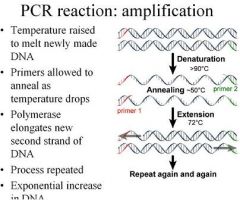
Polymer chain reaction. Used to amplify DNA. 1 cycle of PCR:
Heat DNA to 95 deg C to denature into single strand. Cool to 54 deg C primers can anneal to strands. Heat to 72 deg C optimal temperature for TAQ to work. DNA begins synthesizing on both strands. |
|
|
What are the minimal requirements to set up a PCR reaction?
|
1. DNA template (DNA synthesis)
2. Primers: one for each strand 3. DNA polymerase: Taq polymerase from thermus aquaticus 4. Three water baths: 95, 45-55 and 72 deg C + timer |
|
|
Why does PCR produce a DNA chain of a defined length?
|
Primers will stop synthesis when the reach terminating sequences.
|
|
|
What is the significance of hydrogen bonding in structures such as peptides?
|
Hydrogen bonds hold secondary structures together, such as alpha helix and beta pleated sheets. They stabilize folding and allow for conformation changes which are very important for proteins to carry out functions.
|
|
|
What is the amino acid structure of serine?
|
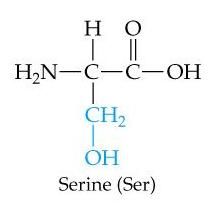
.
|
|
|
What is the structure of Cysteine?
|
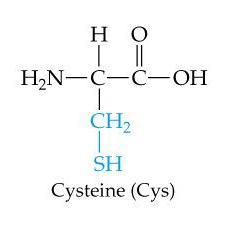
.
|
|
|
Which two elements distinguish DNA from proteins?
|
DNA-phosphate
Protein-sulfer ???more??? |
|
|
How does the bond energy of hydrogen bonds compare to covalent bonds?
|
Covalent bonds are strong. Hydrogen bonds are weak (~1/10 as strong), but can be strong when there are a lot of them.
|
|
|
Describe the characteristics of a hydrogen bond.
|
Can be easily made and broken, which allows for conformational changes. Have specific bond angle and length.
|
|
|
Why can a bond form between -NH2 and =NH? Draw the bond and indicate where the acceptor and donors are.
|
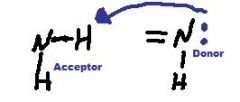
The bond can form because there is no steric hindrance
|
|
|
What is the significance of hydrogen bonding in structures such as proteins?
|
Helps to stabilize proteins
Allows for conformational changes, as in enzymes. |
|
|
Is aromatic stacking the same as the hydrophobic effect, explain.
|
No, aromatic stacking is the result of the hydrophobic effect. This causes flat bases to stack on top of one another.
|
|
|
Proteins contain a mixture of 20 different amino acids, while DNA contains only 4 bases. Why are proteins not used to carry the genetic information?
|
Proteins do not self replicate like DNAs do.
|
|
|
What is the definition of pKa?
|
pKa is the pH midpoint where weak acids and bases are ionized.
|
|
|
What feature of Glycine does not apply to other amino acids?
|
Glycine is the only Achiral amino acid and it is the smallest.
|
|
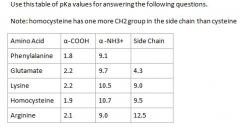
What are the pI values for F?
|
(1.8+9.1) / 2 = 5.4
|
|
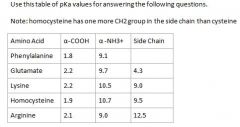
What are the pI values for E?
|
(2.2+4.3) / 2 = 3.25
|
|
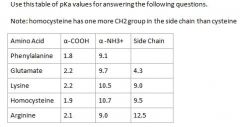
What is the pI of homocysteine?
|
(10.7 + 9.5) / 2 = 10.1
|
|
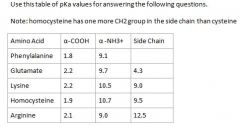
What would be the pI of the tetrapeptide E-K-R-F?
|
(2.2+4.3)/2 (10.5+9)/2 (9+12.5)/2 (1.8+9.1)/2
(3.25+9.75+10.75+5.45)/4 29.2/4 = 7.3 |
|
|
Poly-L-Lysine is a random coil at pH = 7; can it form an alpha helix, and if so, under which conditions?
|
Yes, when pH is above 9 it becomes neutral and can form a helix.
|
|
|
What is the difference between a 3.6(13) and a 3(10) helix? Discuss what the numbers 3.6, 3.0, 13 and 10 mean.
|
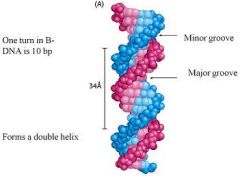
3.6(13) helix is also known as an alpha helix: n -> n+4
3.0(10) helix is also known as a beta turn helix 3.6 & 3.0 is the residues per turn 13 & 10 are the number of bases per turn |
|
|
The peptide bond is the major factor that influences possible protein structures, describe all the specific features of a peptide bond.
|
Resonance - it is in effect a double bond
Results in geometrical isomers: cis or trans Mostly trans and in one plane Bond is meta-stabile (deltaG of hydrolysis is <0) |
|
|
What is a Ramachandran plot and what does it show?
|
Plot shows torsion angles of phi and psi residues of a protein
Indicates that not all conformations are possible due to steric hindrance |
|
|
What is the difference between a protein motif and a protein domain?
|
Motif is various arrangements of alpha helices and beta sheets
Domain is composed of varying motifs |
|
|
Which amino acids are polar?
|
Q, N, D, E, H, K, R, S, T, Y
Question, No DEH KRSTY |
|
|
What is the one letter abbr. for Ala?
|
A
|
|
|
What is the one letter abbr. for Arg?
|
R
|
|
|
What is the one letter abbr. for Ser?
|
S
|
|
|
What is the one letter abbr. for Asp?
|
D
|
|
|
What is the one letter abbr. for Asn?
|
N
|
|
|
What is the difference between a protein motid and a protein domain?
|
Motif - is various arrangements of alpha helices and beta strands
Domain is composed of varying motifs |
|
|
Draw a Greek Key Motif.
|

Greek Key, Saddle, Barrel, & Meander are all beta-motifs
|
|
|
Draw a Meander Motif
|
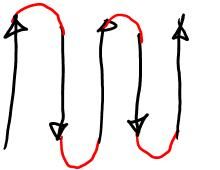
.
|
|
|
Draw a Meander Motif
|
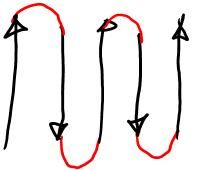
.
|
|
|
What is the difference between barrel and saddle motifs?
|
Barrel Motif - antiparallel
Saddle Motif - parallel |
|
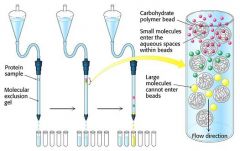
What technique is shown in this picture?
|
Gel filtration separates the proteins by size. (large molecules towards the bottom & small molecules towards the top)
|
|
|
What is the reason for Ammonium sulfate precipitation?
|
Salting out precipitate for concentration
|
|
|
What is the reason for ion-exchange chromatography?
|
Separate proteins by their charge
|
|
|
What is the reason for Polyacrylamide gelelectrophoresis?
|
Separate by mass
|
|
|
What is the reason for Hydrolysis with HCl?
|
Separate for sequencing
|
|
|
What is the reason for Trypsin Digestion?
|
Cleaves C-end of R&K
|
|
|
What is the reason for Phenylisothiocyanate Treatment?
|
Edman degradation determines N end of protein.
|
|
|
Although the Sanger Method was a breakthrough in biochemistry, why is it not as useful as newer methods?
|
Peptides were lost through hydrolysis no info of amino acids termina.
Edman degradation recovered peptides that were lost during sequencing. |
|
|
The octapeptide AVGWRVKS was digested with trypsin. would you separate the resulting peptides by ionexchange chromatography or gel filtration. What would you use after digestion with chymotrypsin. Explain your answer.
|
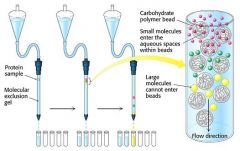
Trypsin - will yield AVGWR, VK, & S
Use gel filtration because the peptides are all different sizes |
|
|
What are some tools that are critical to gene exploration?
|
Restriction Enzymes
Blotting and Hybridization DNA sequencing Chemical DNA synthesis PCR (Polymerase Chain Reaction) Computer Analysis Data bases |
|
|
How are Restriction Enzymes used in gene exploration?
|
Restriction Enzymes -restriction endonucleases; sequence specific hydrolases
|
|
|
How is Southern Blot Analysis used in gene exploration?
|
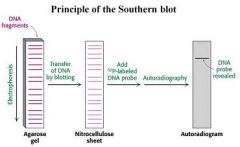
1. Restriction enzyme digestion
2. Agarose gel electrophoresis 3. Dentaturation of DNA 4. Transfer to an inert carrier material membrane 5. Attachment of ssDNA to membrane 6. Hybridization with a Probe (DNA for Sourthern blot or RNA for Northern blot) |
|
|
Why does DNA sequence analysis require a Dideoxynucleoside triphosphate?
|
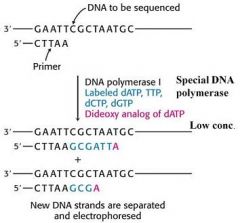
It causes termination of replication allowing for specific fragments
|
|
|
Why is the Sanger method not as good as newer methods?
|
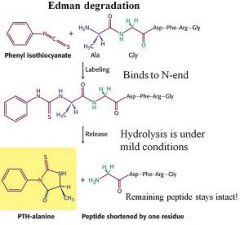
The Sanger method (1-fluoro-2,4-dinitrobenzene) reacts with N-end of a peptide. That N-end binds to DNP, which labels with a yellow color. Unfortunately the rest of the peptide is hydolyzed irreversibley.
Phenyl isothiocyanate is used in Edman degradation. It binds to the peptideat the N end and the remaining peptide stays intact. |
|
|
The octapeptide AVGWRVKS was digested with trypsin. Would you separate the resulting peptides by ion exchange chromatography or gel filtration?
|
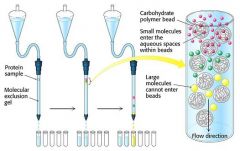
Trypsin cleaves at C-end of K&R.
AVGWR, VK, S Use Gel Filtration, because they are different sized peptides. |
|
|
The octapeptide AVGWRVKS is digested with chymotrypsin. Would you separate the remaining peptides by ion exchange chromatography or gel filtration?
|
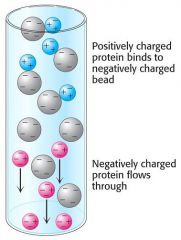
Chymotrypsin breaks bonds at the C-end of Y,W,F, & M.
The resulting peptides are AVGW & RVKS. Since these peptides have the same amount of amino acids you should use ion exchange. |
|
|
How are peptides separated in Gel Electrophoresis?
|
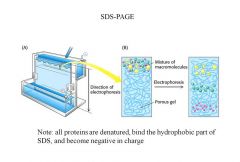
All the proteins are denatured and become negatively charged.
A current is applied and the peptides travel toward the bottom of the porous gel. The smaller peptides reach the bottom faster because they have less surface area and do not create as much friction as they travel through the gel. |
|
|
What is the N-glycosidic bond in nucleotides and between which atoms is this bond?
|

N-glycosidic bond links sugars to bases
N-9 of a purine or N-1 of a pyramidine is attached to the C-1 of a sugar. |
|
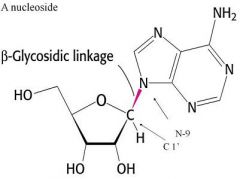
Name 2 specific features of this bond and their implication for DNA structure.
|

The bases in a base pair are not in one plane: Twist Angle
The bases are at a certain angle with respect to the backbone: Tilt Angle The N-glycosidic bonds in a base pair are not opposite: Results upon rotation in a MAJOR & MINOR GROOVE |
|
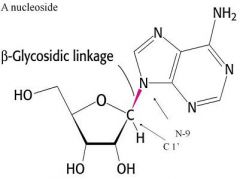
What position is the N-glycosidic bond in for normal DNA?
|
Anti
(note: rotation makes it syn and results in a different form) |
|
|
Draw the general structure of a purine base and a pyramidine base, indicate with which atom they are attached to the sugar.
|
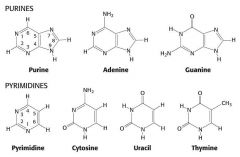
N-9 of a Purine
N-1 of a Pyramidine |
|
|
What are the minimal requirements for DNA replication?
|

Replication is 5'->3'
Free 3' -OH group Primer dNTPs ssDNA template strand DNA polymerase enzyme |
|
|
Why does DNA sequence analysis require a dideoxynucleoside triphosphate?
|
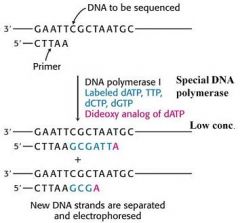
dideoxynucleoside triphosphate stops the DNA elongation at a specific point
|
|
|
Finish this potential DNA restriction enzyme site (6 base pair cutting).
C T C_ _ _ _ _ _ _ _ _ |
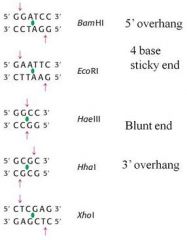
CTCGAG
GAGCTC (note: recognition sequence for restriction enzymes are palindromes) |
|
|
Show how this enzyme would cut in order to produce 5' recessed ends:
GGATCC CCTAGG |
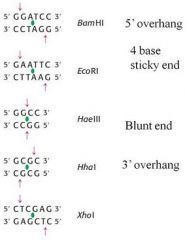
.
|
|
|
What causes a protein to fold?
|
1. Primary structure orders the residues
2. Water causes the hydrophobic effect 3. Interactions stabilize the molecule: salt bridges, S-S bonds, H-bonds, Van der Waals interactions |
|
|
What does it mean that DNA has anti-parallel strands?
|
DNA is in opposite directions.
5'->3' 3'->5' |
|
|
What does it mean that DNA has complementary strands?
|
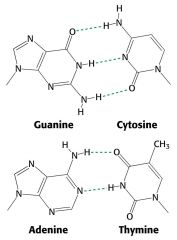
Base pairs are complementary.
Complementary base pairs cause a conservation of information. |
|
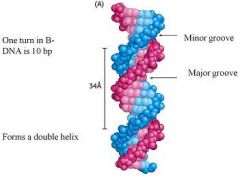
What does it mean that DNA has is a double helix?
|
two helices intertwine around each other.
|
|
|
What does it mean that natural DNA is in the B form
|
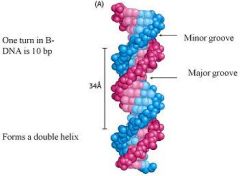
Beautiful DNA
Tilt angle is 1 deg N-Glycosidic bond is in the anti position |
|
|
What are the minimal requirements to set up a PCR?
|
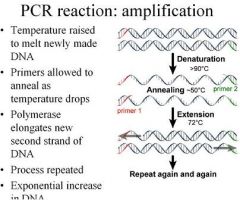
1. DNA template (DNA synthesis)
2. Primers: one for each strand (known sequence) one sense and one antisense 3. DNA polymerase: Taq polymerase (from Thermus AQuaticus) 4. Three water baths: 95, 45-55 and 72 deg C + timer |
|
|
What is PCR?
|
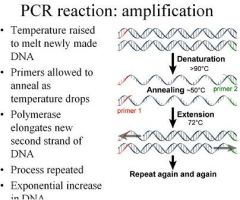
Amplifying DNA by annealing primers
|
|
|
Why does PCR produce a DNA chain of a defined length?
|
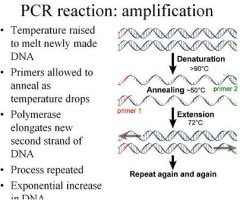
No 3'-OH primer results in specific termination
|
|
|
What is enthalpy, how is it measured and why is it used?
|

H is the enthalpy
It is used to determine the heat required by chemical reactions. |
|
|
What is the equation for free energy change?
|

...
|
|
|
What is delta Go'?
|
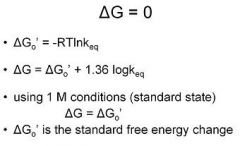
-RTlnKeq
|
|
|
What is Cyanogen bromide treatment used for?
|
cleaves amino acids at the C end of M
|
|
|
What did Meselson and Stahl Prove and why was this such an elegant experiment?
|
They proved the hypothesis that DNA replication was semiconservative.
It was elegant because it was very obvious and easy to see. |
|
|
Under what condition is delta Go' =-RTlnKeq?
|
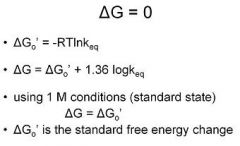
When delta G=0
|
|
|
Tris has a pKa of 8.3. At pH 9.3 what will be the fraction of conjugate base?
|
pH=pKa+ log [A-]/[HA]
9.3 =8.3 +log Tris/TrisHCl log Tris/Tris/HCl = 9.3-8.3 = 1 Tris/TrisHCl =10^1 = 10 Fraction of Conj Base = 10 |
|
|
What is the definition of pKa?
|
???
|

